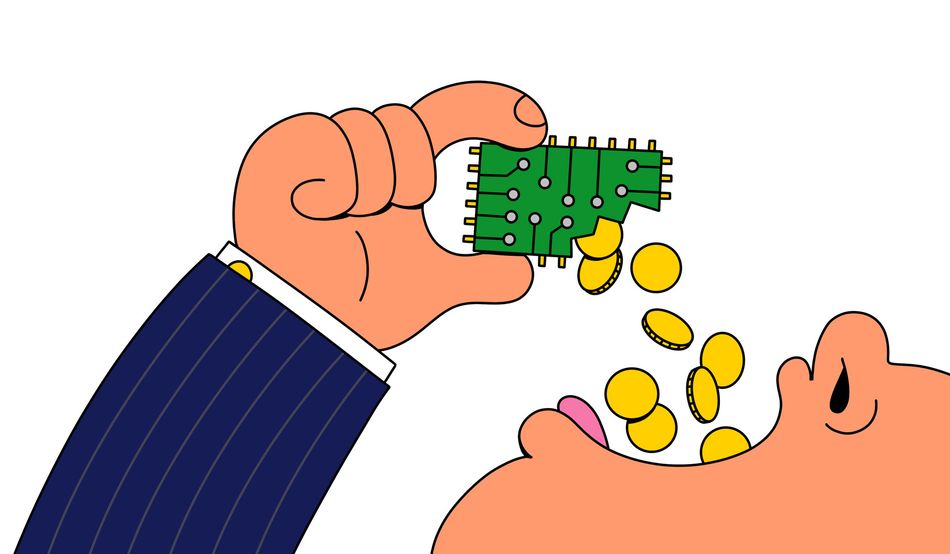When Donald Trump took the oath of office for the second time in January 2025, he was surrounded not just by politicians and dignitaries, but by the CEOs of six of the world’s most visible technology companies: Amazon, Google, Meta, X, TikTok and Apple. This display of fealty to the American leader made business sense—Trump has now delayed the national ban on TikTok three times, with no clear legal basis, but with great benefit to CEO Shou Zi Chew, who posted an effusive thank you to Trump on his platform. But beyond good politics, the tech CEOs on the dais represented a shift that’s become increasingly apparent over the last decade: big tech’s lurch to the right.
I come from a generation of technologists who assumed, arrogantly and naively, that technologies such as the personal computer and the internet were inherently liberatory and that the politics of those involved in the tech industry were left-leaning. The politics of most of my colleagues in the early 1990s was even more dismissive than that: we tended to assume that politics was for people less smart and productive than we were.
There’s a fascinating history behind this set of beliefs, elucidated by Stanford University historian Fred Turner in a 2006 book called From Counterculture to Cyberculture. Turner traces the evolution of Silicon Valley’s politics through Stewart Brand, who introduced America’s hippies and back-to-the-land movement to personal computers through the Whole Earth Catalog, an eclectic index of everything from organic seeds and yurt plans to a $4,400 programmable calculator. (The “personal computer” dates to the Altair 8800 in 1974, so Brand and colleagues were well ahead of the pack in 1971.) Fourteen years later, Brand co-founded the Whole Earth ’Lectronic Link (WELL), a much celebrated online community whose liberal Californian norms influenced early online culture.
Propelling Brand’s embrace of early computers was the idea that technologies associated with corporate control and conformity could be tools for rebellion and creativity, if put into the hands of “the people”. By the time Mark Zuckerberg became the avatar of the digerati in the mid-2000s, hippie-era suspicion of technology had been replaced with a confidence that computers—and the internet, specifically—were liberatory by their very nature, likely to reshape our world in ways politicians could only dream of. Essayist George Packer, writing about the politics of the tech industry, recounts the story of an employee of a Silicon Valley company, who decides not to waste his programming time by attending a visit from President Obama: “I’m making more of a difference than anybody in government could possibly make.”
This “tech will change the world” mentality reached its zenith during the Arab Spring protests between 2010 and 2012. Organisers of protests in Tunisia and Egypt credited platforms like Facebook and YouTube with providing them a way around censored media channels. The idea that the internet was inherently democratising animated foreign policy in the US and Europe, leading to a wave of funding for anticensorship tools and efforts to bring connectivity to closed societies like Cuba.
But the technologies currently capturing the attention of technologists—and the policymakers who regulate them—have a very different politics baked into them. Cryptocurrency has long been a subject of interest for libertarians, who fear that government-backed currencies can lose value when it’s politically convenient for leaders to overspend. Bitcoin’s mysterious creator, Satoshi Nakamoto, referenced his distrust of financial policymakers in a 2009 post explaining his motivations: “The central bank must be trusted not to debase the currency, but the history of fiat currencies is full of breaches of that trust.” A currency that relies on trust in maths, rather than trust in governments, is a libertarian’s dream.
Unfortunately, cryptocurrencies have also become a haven for conmen and grifters. From ponzi scheme OneCoin, which fleeced investors of more than $4bn between 2014 and 2017, to Sam Bankman-Fried’s embezzlement at FTX, which lost $8bn in customer funds (though it may recover most of these losses due to increases in the value of crypto), to the outright theft of $1.46bn in cryptocurrency by North Korean hackers from crypto exchange Bybit, cryptocurrencies are clearly a dangerous investment, at least for some buyers.
That hasn’t stopped the Trump administration from signing the GENIUS Act, which promotes “stablecoins”, a category of cryptocurrency designed to be less volatile because it is backed by more reliable assets. Critics of stablecoins argue that they are essentially poorly regulated banks, with few licensing requirements and little protection against money laundering. More significant may be the ways stablecoins add a veneer of legitimacy to riskier crypto assets such as memecoins. These coins, with names like Moo Deng coin and Fartcoin, are designed to be “digital collectibles” with no actual value. Yet the “market cap” of some of these coins is in the billions of dollars.
One of the most valuable memecoins is the “Official Trump” memecoin—stylised as $TRUMP—issued a few days before Trump’s second inauguration. Two Trump-owned companies own 80 per cent of the coins, and the holdings represent a significant portion of Trump’s purported wealth. Yet a recent analysis suggests that 764,000 small investors have lost money on the coins, while 58 crypto wallets have made at least $10m each. It’s hard to think of a better metaphor for Trump’s vision for the US economy than an imaginary asset that steals from the poor to give to the rich.
It’s worth mentioning that some of those buyers of $TRUMP were seeking invitations to a meeting with the president, who dined with the top 220 holders of his digital collectible. And just to ensure no aspect of digital currency goes uncorrupted, Trump and his sons started World Liberty Financial, which issues a stablecoin that’s been used to facilitate crypto investments by an Emirati firm, lining Trump’s pockets with transaction fees.
If the politics of crypto have shifted from libertarian to oligarchic and kleptocratic, the rise of AI offers a different right-leaning politics: corporatocracy. The large language models that dominate attention to and investment in AI are based around a single very clever trick: they ingest billions of documents created by humans and output plausible answers extrapolated from those texts. The contributions, quirks and foibles of those individual authors blur into a single voice, that of an impossibly large machine owned by a billion- or trillion-dollar company.
Whether or not we believe future AIs will discover cancer cures or cold fusion, it’s likely that those who make money off of AIs will be the corporations pouring vast sums of money and electrical power into their machine learning models. AI, as currently implemented, is anti-worker, both in that it seeks to replace meaningful jobs with optimised models, and that those models can only be built and run by corporations with tremendous resources. Karl Marx himself couldn’t have imagined a better example of alienation than watching the products of scholarship and thought transformed into feedstock for the capital-intensive work of “knowledge production”.
These political shifts around technology—from a space of presumed liberation to a strong alignment with the worst aspects of late-stage capitalism—has an odd consequence: now every technical conversation is political. There’s the temptation to assume that someone excited about cryptocurrency or AI cares nothing for the environment or workers’ rights, and is worthy of condemnation simply for their area of interest. And yet, that presumption closes down the most interesting and important dialogues we could be having about technology. Can we have AI that’s good for workers and the environment? Is there a vision of digital money that empowers the powerless, and not just the kleptocrats?
Researching this column, I went to a university library and pulled out a copy of the Whole Earth Catalog from 1971. An organisation called “Computer People for Peace” had taken out a full-page ad, asking readers to consider “the present misuse vs. constructive potential of computer technology” and to consider “the role of automation on the rising level of unemployment”. The tension between different possible futures for technology is not a new one, but it is perhaps more urgent than ever.














